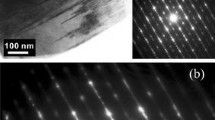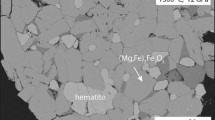Abstract
The decomposition of fayalite (Fe2SiO4) in oxygen potential gradients is studied at T=1,418 K. The compound will be decomposed into its component oxides wüstite, Fe1−δO, and silica, SiO2, by the simultaneous action of two different oxygen partial pressures, exceeding a critical ratio, despite the fact that fayalite is stable at both the lower and the higher oxygen potential. A quantitative analysis of the decomposition process caused by defect fluxes within the bulk Fe2SiO4 is given.
Similar content being viewed by others
References
Borchardt G, Schmalzried H (1971) Silikatbildung im festen Zustand. Z Phys Chem NF 74:265–283
Brindley GW, Hayami R (1965) Kinetics and Mechanism of formation of forsterite (Mg2SiO4) by solid state reaction of MgO and SiO2. Phil Mag 12:505–514
Buening DK, Buseck PR (1973) Fe-Mg lattice diffusion in olivine. J Geophys Res 44:6852–6862
Darken LS, Gurry RW (1945) The system iron-oxygen I. The wüstite field and related equilibria. J Am Chem Soc 67:1398–1412
Duckwitz CA, Schmalzried H (1971) Reaktionen zwischen festen Oxiden unter Einschluß von Gastransport. Z Phys. Chem NF 76:173–193
Hallwig D, Schachtner R, Sockel G (1982) Diffusion of Magnesium, Silicon and Oxygen in Mg2SiO4 and formation of the compound in the solid state. In: Dyrek K, Haber J and Nowotny J (eds) Reactivity of Solids, Proceedings of the 9th International Symposium on the Reactivity of Solids, Elsevier Science Publishers, Amsterdam, pp 168–172
Hermeling J (1984) Eisentracerdiffusionskoeffizienten im Mischkristall (Fe x Mg1−x )2SiO4. Ph D Thesis, Universität Hannover: 66–68
Hermeling J, Schmalzried H (1984) Tracerdiffusion of Fecations in olivine (Fe x Mg1−x )2SiO4(III). Phys Chem Minerals 11:161–166
Lenz JG, Nicholson PS, Smeltzer WW (1977) Diffusion controlled reaction between β-quarz and magnesia. J Am Ceram Soc 60:370–371
Martin M, Schmalzried H (1985) Cobaltous oxide in an oxygen potential gradient: morphological stability of the phase boundaries. Ber Bunsenges Phys Chem 89:124–130
Nakamura A, Schmalzried H (1983) On the nonstoichiometry and point defects of olivine. Phys Chem Minerals 10:27–37
Nakamura A, Schmalzried H (1984) On the Fe2+-Mg2+-interdiffusion in olivine (II). Ber Bunsenges Phys. Chem 88:140–145
Reddy KPR, Oh SM, Major LD, Cooper AR (1980) Oxygen diffusion in forsterite. J Geophys Res 85:322–326
Schmalzried H (1965) Point defects in ternary ionic crystals. In: Progress in Solid State Chemistry 8:265–308
Schmalzried H (1978) Reactivity and point defects of double oxides with emphasis on simple silicates. Phys Chem Minerals 2:279–294
Schmalzried H, Laqua W, Lin PL (1979) Crystalline oxide solid solutions in oxygen potential gradients. Z Naturforsch 34a:192–199
Schmalzried H, Laqua W (1981) Multicomponent oxides in oxygen potential gradients. Ox Metals 15:339–353
Sockel HG (1974) Defect structure and electrical conductivity of crystalline ferrous silicate. In: Seltzer MS and Jaffee RI (eds) Defects and transport in oxides. Plenum, New York, pp 341–354
Windhager HJ, Borchardt G (1975) Tracerdiffusion und Fehlordnung in dem Orthosilikat Co2SiO4. Ber Bunsenges Phys Chem 79:1115–1119
Yamaguchi G, Tokuda T (1967) Some aspects of solid state reactions between oxides. Bull Soc Japan 40:843–851
Author information
Authors and Affiliations
Rights and permissions
About this article
Cite this article
Brinkmann, U., Laqua, W. Decomposition of fayalite (Fe2SiO4) in an oxygen potential gradient at 1,418 K. Phys Chem Minerals 12, 283–290 (1985). https://doi.org/10.1007/BF00310341
Received:
Issue Date:
DOI: https://doi.org/10.1007/BF00310341




